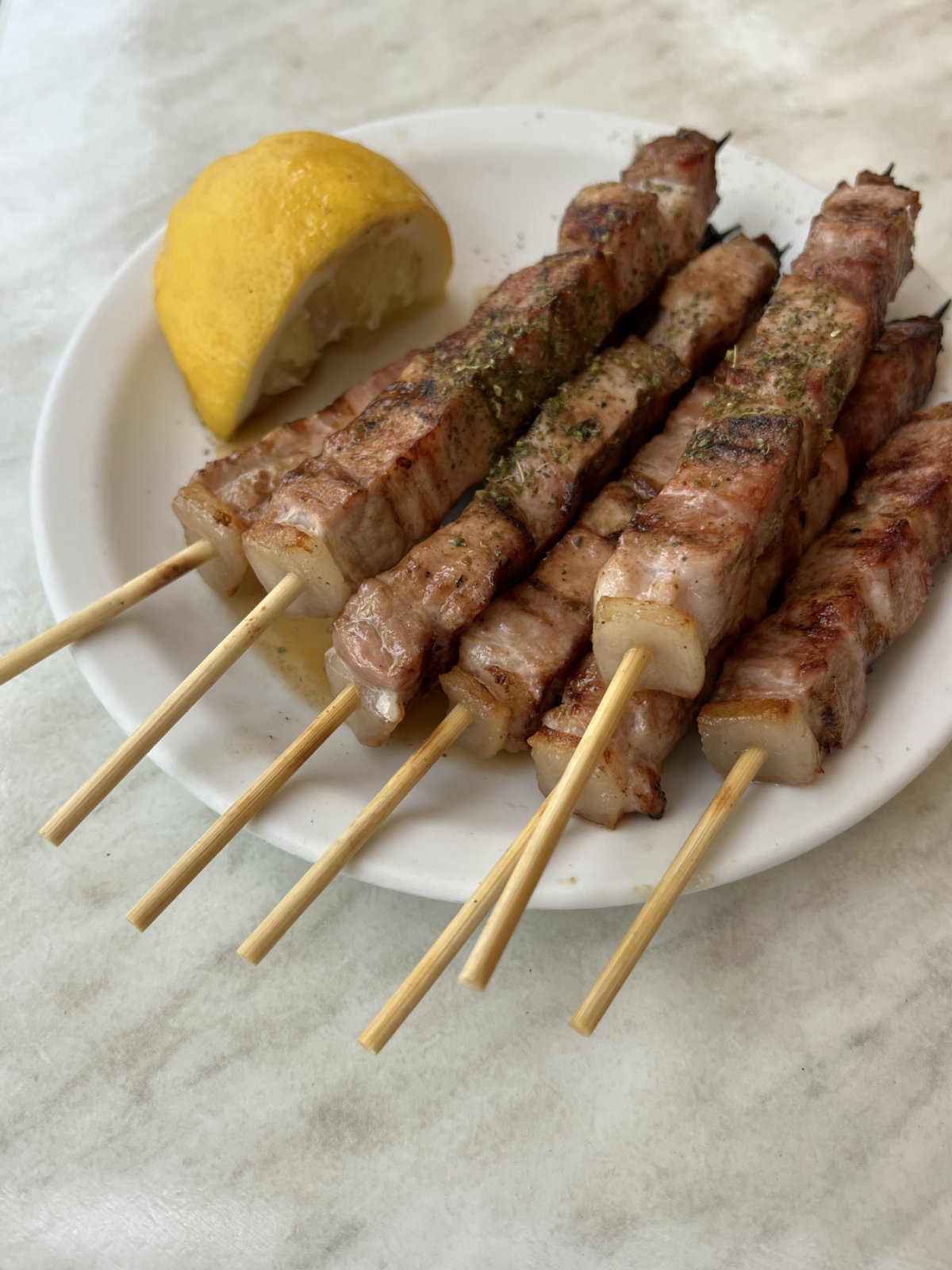
In the Footsteps of Arpaxos
In June I was able to spend ten days in Greece, traveling with my wife. I went primarily to reconnect to Anghelika’s siblings and mom – it had been 14 years since I’d been there, and I missed them. I had, after all, married all three of the Elliott Sisters in Greece, one as husband (I am writing this on my own wedding anniversary), and two as officiant. Brother Stephen made sure to tell me, after Maggie was married to Jimmy, and after Lucy was married to Andrew on a small island off of Eretria, that he himself was now free to marry – highlighting a Greek tradition that young men will wait for marriage until their sisters are accounted for – and he thanked me in particular for doing my part.
Besides family, I was excited for several things I knew I would be able to enjoy. In no particular order: food, family art, and the beauty of old churches (and I enjoyed them all) …
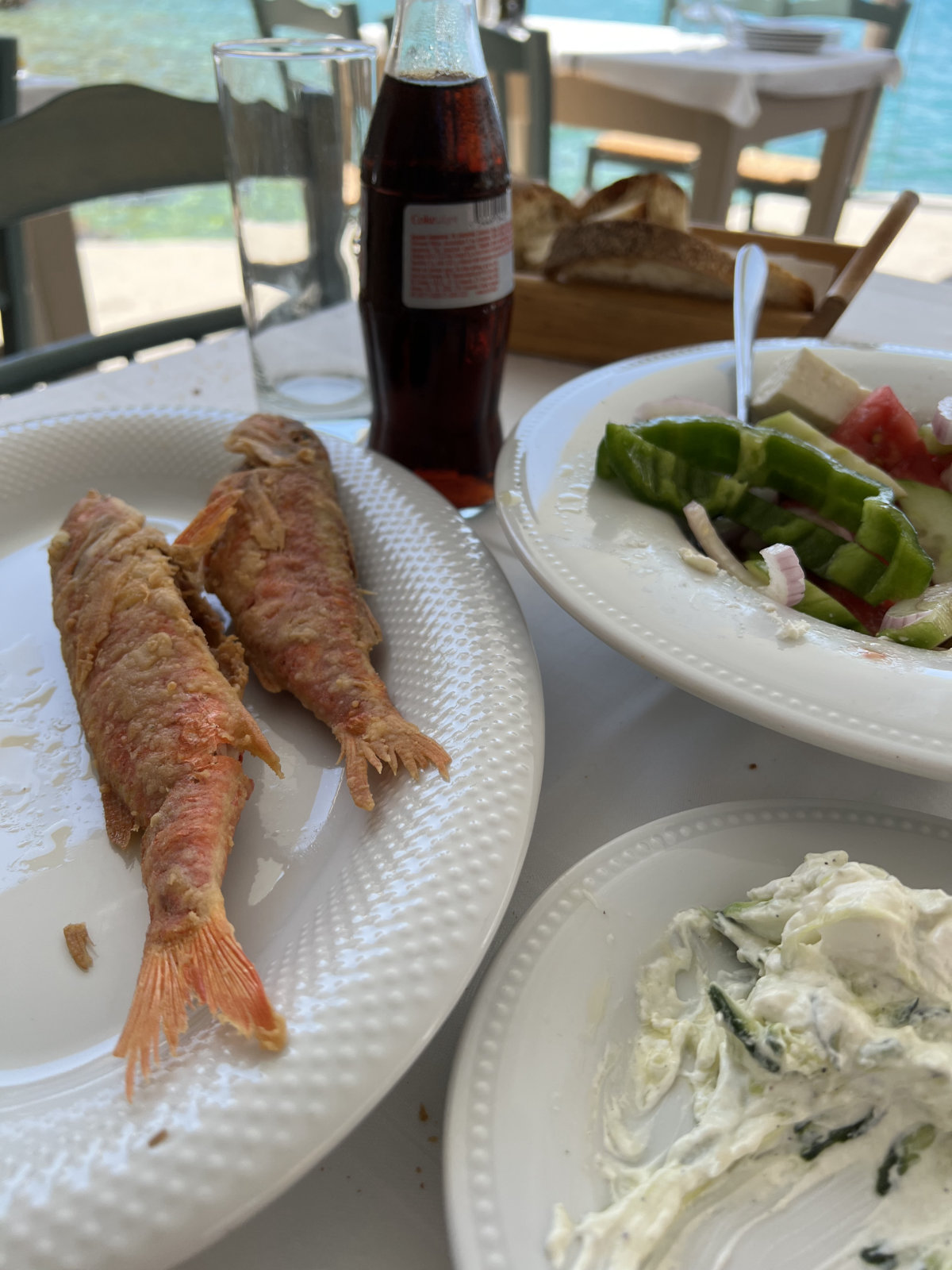
Anghelika’s grandfather, Spyros Vassiliou, was a well-known painter and something of a national treasure. Whenever I return to Greece, I seek out his artworks. A favorite theme of his from during and after the German occupation was freedom. Here is a three-color woodcut print showing Eleutheria setting the captives free. (Paint was hard to get during the war, wood was not.) I chose a similar image as the frontpiece for Abrasion, the first of three stories that became Echoes of a Future Truth.

A favorite theme of mine is the design language of orthodox churches. Unlike the inarguably beautiful, soaring fan-vaults of gothic churches, which seem only to communicate a great ambiguous space above you, and seem to extend the distance from the doorway to the altar as far as possible, the orthodox church, especially in the cruiciform style, makes every painted surface feel close, like an opportunity for intimate devotion, ones own window into heaven. The pilgrim has a front row seat at the unfolding, scene by scene, of the drama of faith history. These spaces, no matter how large, feel like a refuge, a holding space, equally intimate for the gathered community and for each individual, not a bad seat in the house.
The (one time) Cathedral of Aghiou Dimytriou in Athens, bringing two of my pleasures together – Grandpa Spyros painted the frescoes throughout the interior of this most beautiful church.
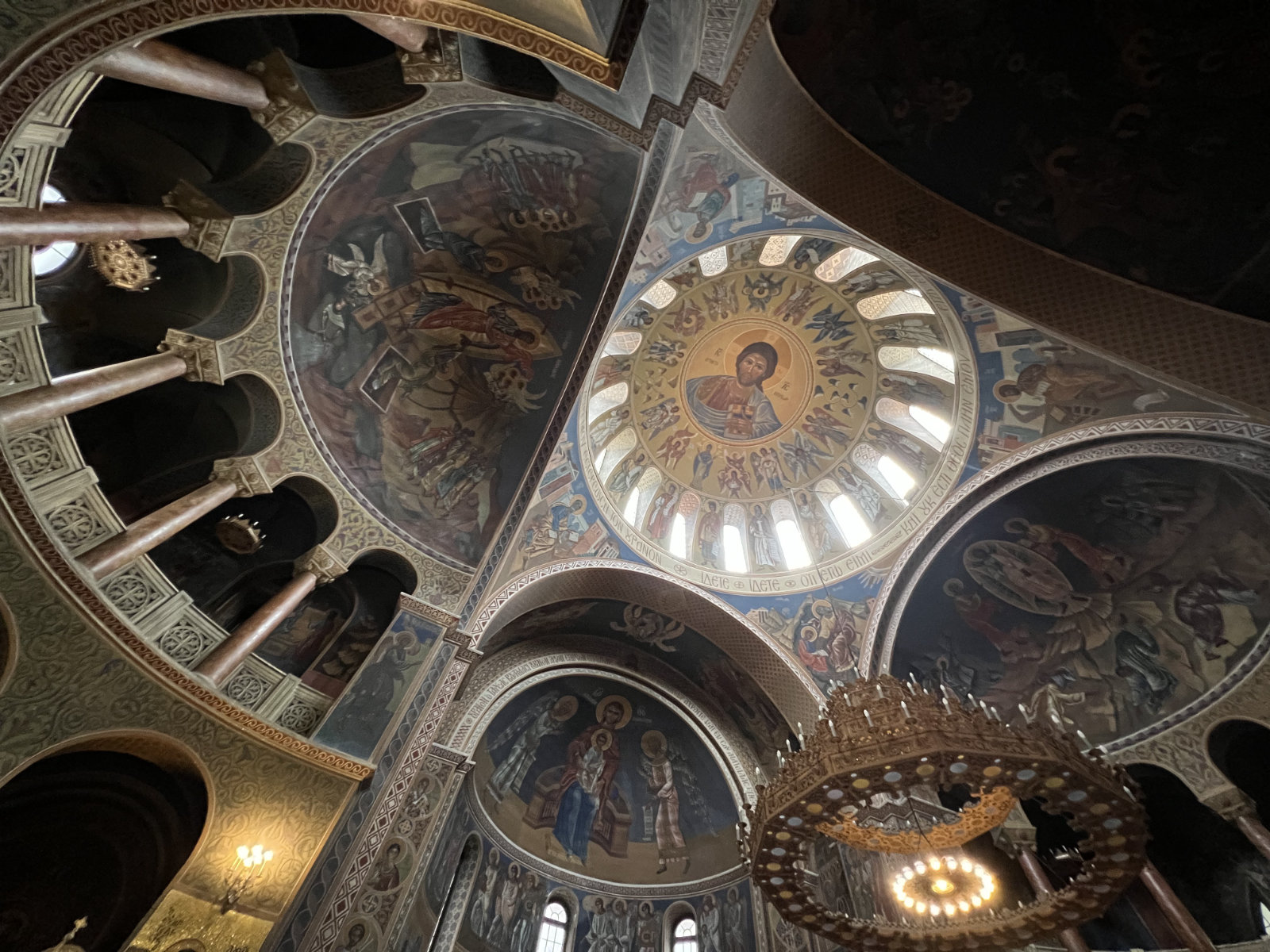
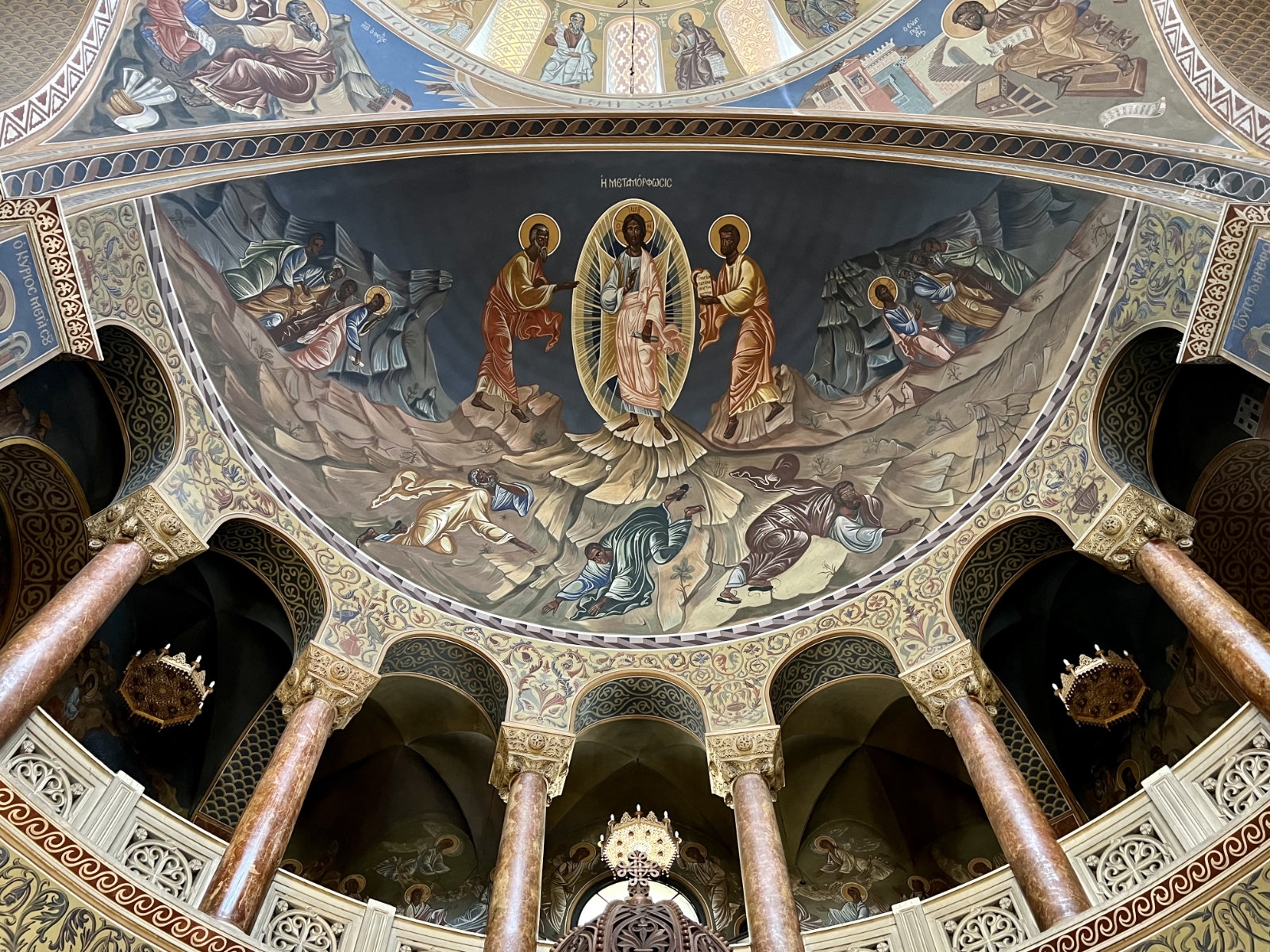
And an exterior detail of a smaller church in Mani, showing a similar organic ethic in design … shapes and textures that feel very human in scale and quality … especially if that human is a resident of the wilder places in Greece.
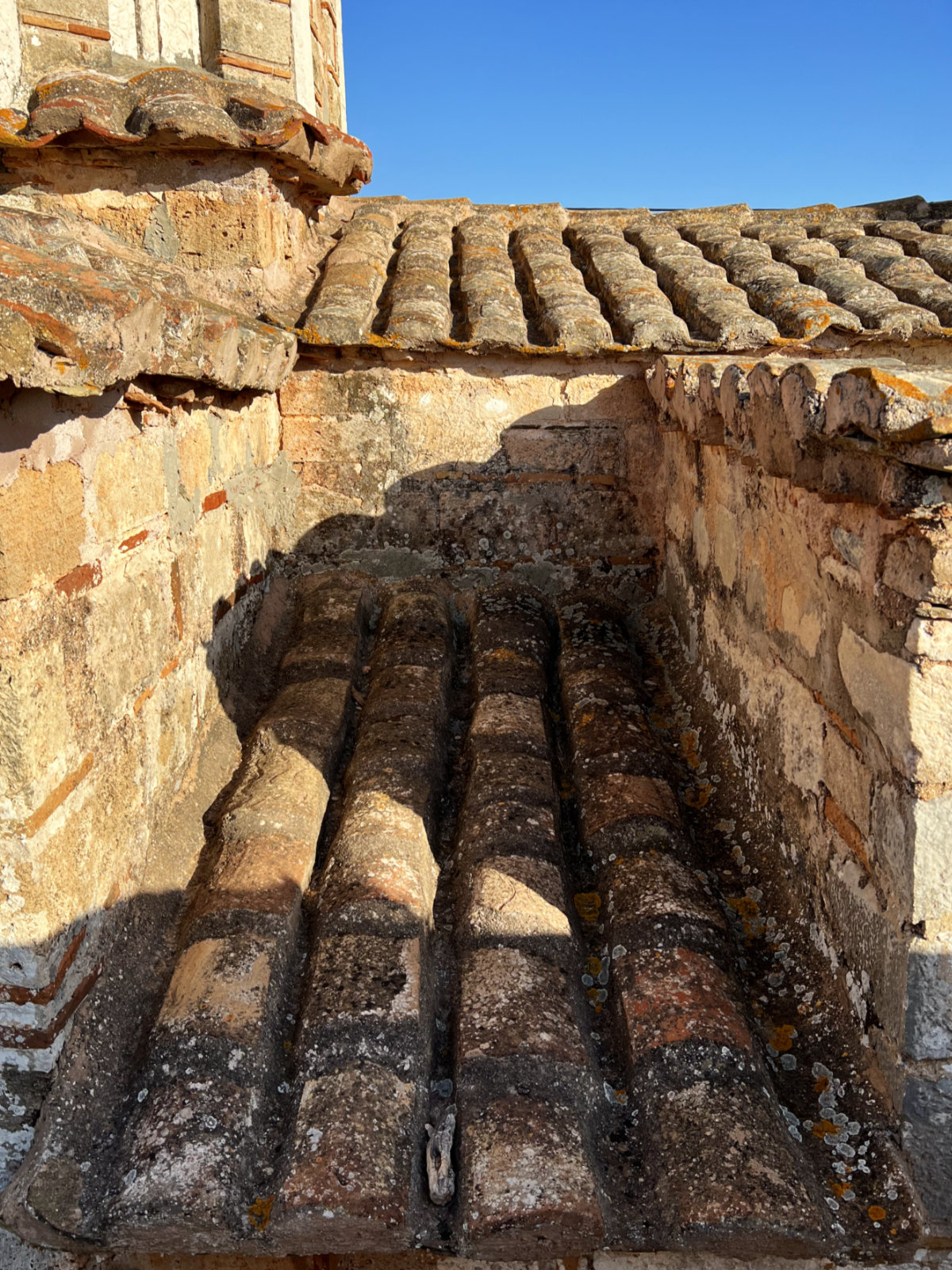
Mani in the Footsteps of Arpaxos
Owing to the short duration of our trip, I held out little hope I’d be able to do much touring, but I had my character Arpaxos in mind (Arpaxos is the antihero of Isolation, the second part of my novel Echoes of a Future Truth). His adventures take place entirely in Greece and primarily on the Mani Peninsula of the Peloponese. When COVID hit the family just before we arrived, we realized we had a few days to spend on our own; we headed out to walk the paths he took across the Mani Peninsula.
I’m here to tell you, Arpaxos got away from it all. Anghelika and I attempted to reach the church of his self-imposed exile, on the southwestern cape of Mani, but were hindered by the ruggedness of the terrain. Though the churches in Isolation are amalgams of the many old Greek churches I have visited, I had never been to the two in the story, which were found on maps and chosen for their remoteness. The character arrives at a small church on the top of the cliffs of Cape Grosso, called Agia Sotira (= ‘of the savior’), and expects to spend his last days there. He stumbles onto another, smaller church built within a cave, halfway down the cape’s western cliffs, called Agia Eleousa (= ‘of the merciful one’).
Here they both are on a satellite image of the peninsula, shown East-Up, in the style of some ancient maps. You can see one of Arpaxos’ stops at the top-left: Gytheon (a name that combines the Greek words for Earth and God), where Anghelika and I set up a cozy base camp. The two churches are down on the bottom-right, marked in yellow.
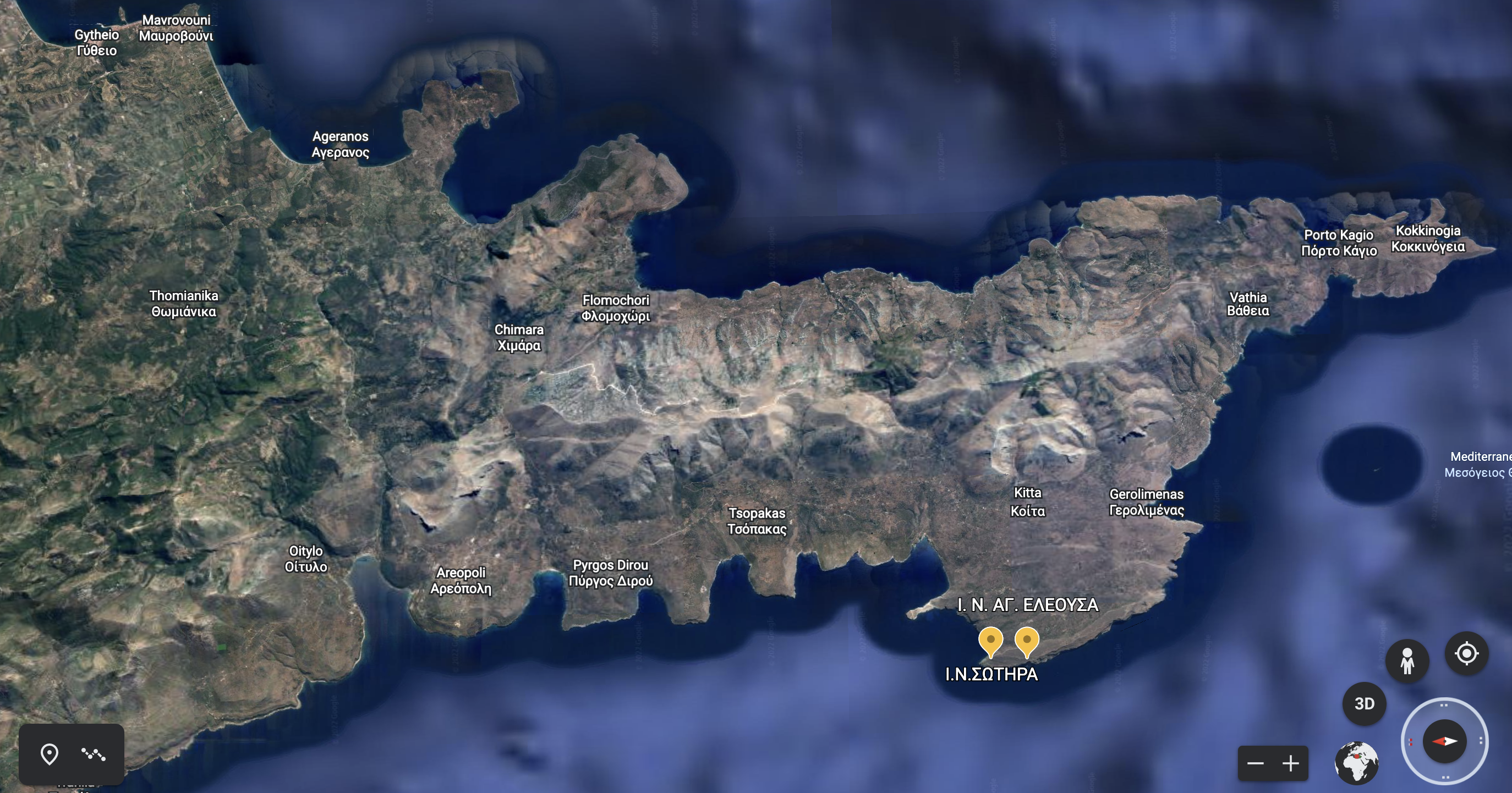
To Agia Sotira
We made two attempts to get to Sotira on the ridge of the massive Cape Grosso (grosso means a bulk or mass). this image is taken from the Tigani Peninsula to the north-east, a perspective that suggests no easy access …
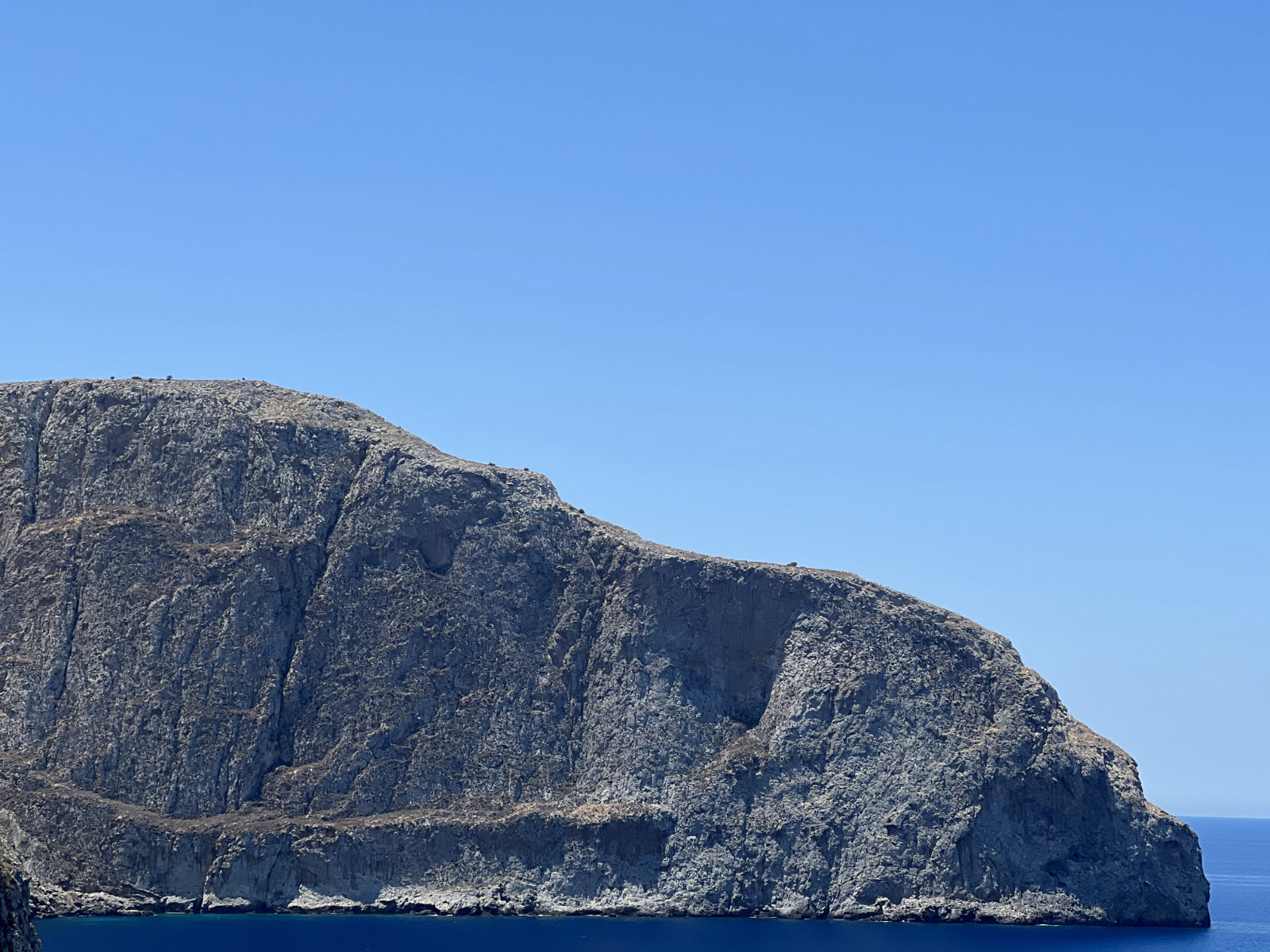
We hoped to use a trail from the south – visible on my Greek army topo map – shown climbing up a smaller east face, then turning along the ridge to take us to the lonely church at the northern tip; the greek printed alongside the trail, ξεμουντο, is an archaic word that appears to mean ‘went out’ (I asked my mother-in-law first and she did not recognize it … the internet provided this meaning).
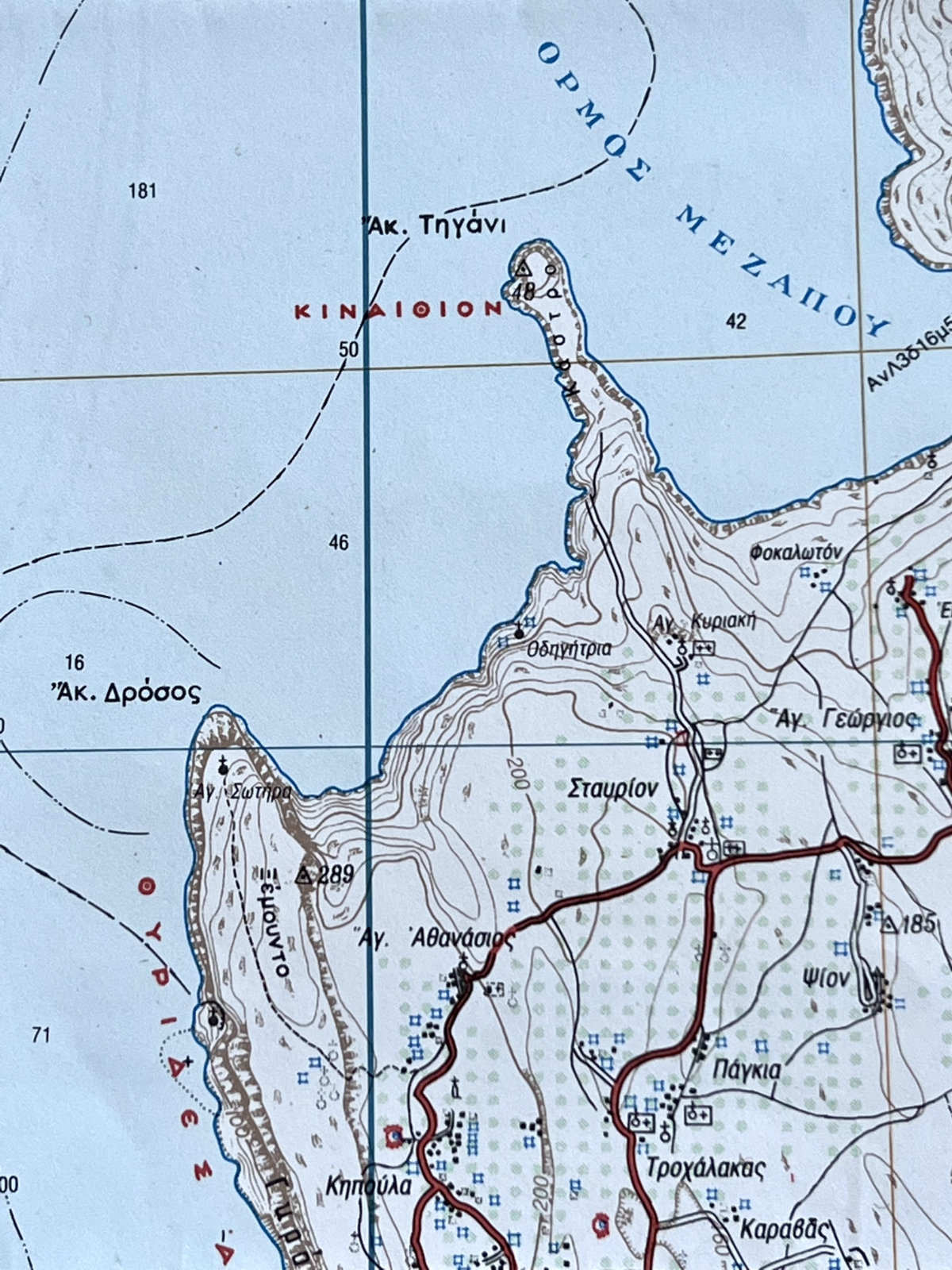
However, after trying with all the tools available to us (digital and paper maps, satelite images, GPS, and all my backcountry experience in the US and Greece), we had to give up on this route. We learned from a local man we met later in the day that ‘this trail has collapsed’. He was one of only two locals we encountered in several hours of driving and scouting this part of Mani. Here is a view of where the neglected trail begins, between two old orchard walls …
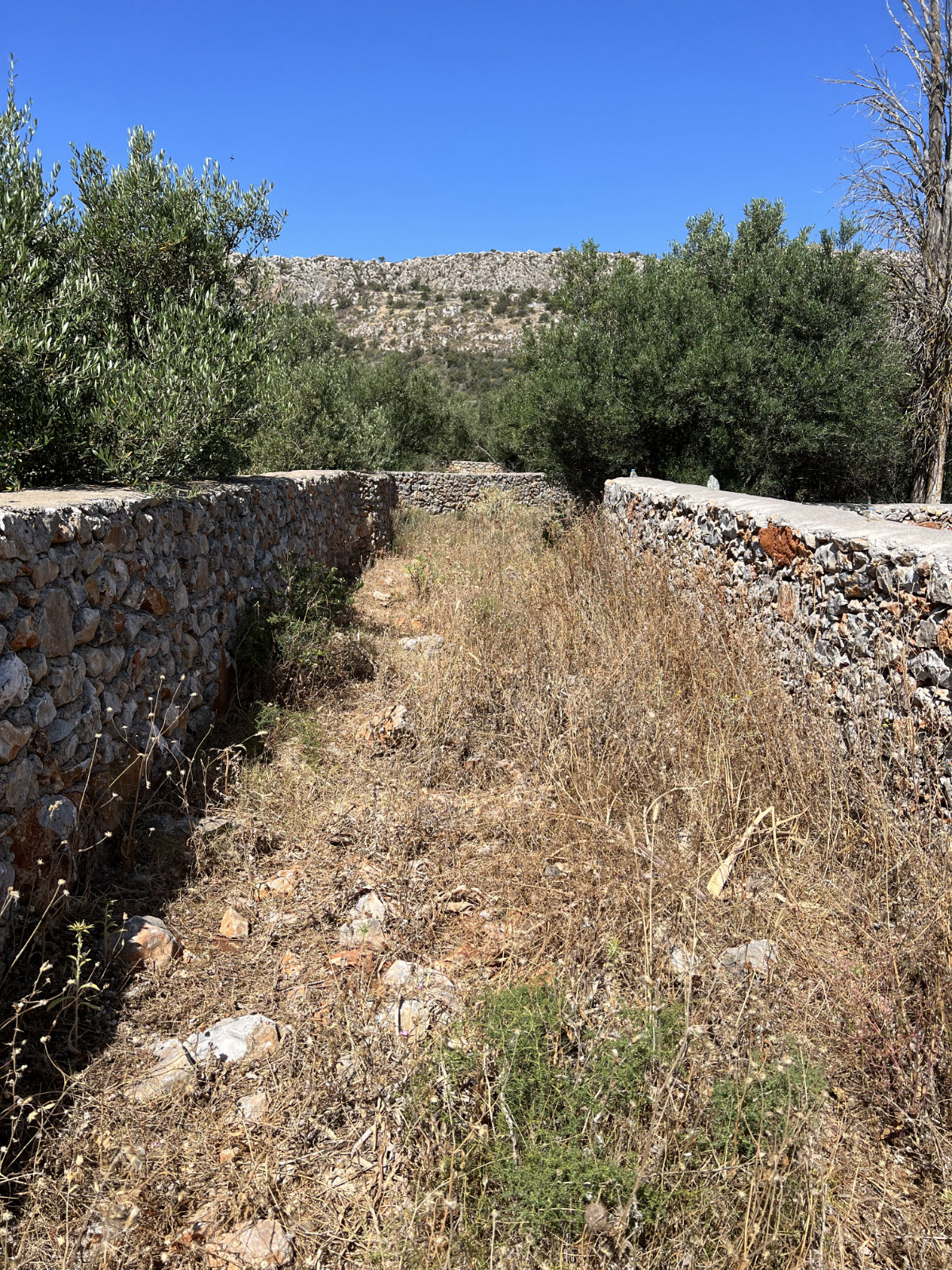
And, what we soon encountered: wild bushes obscuring a path that should have taken us up the face …
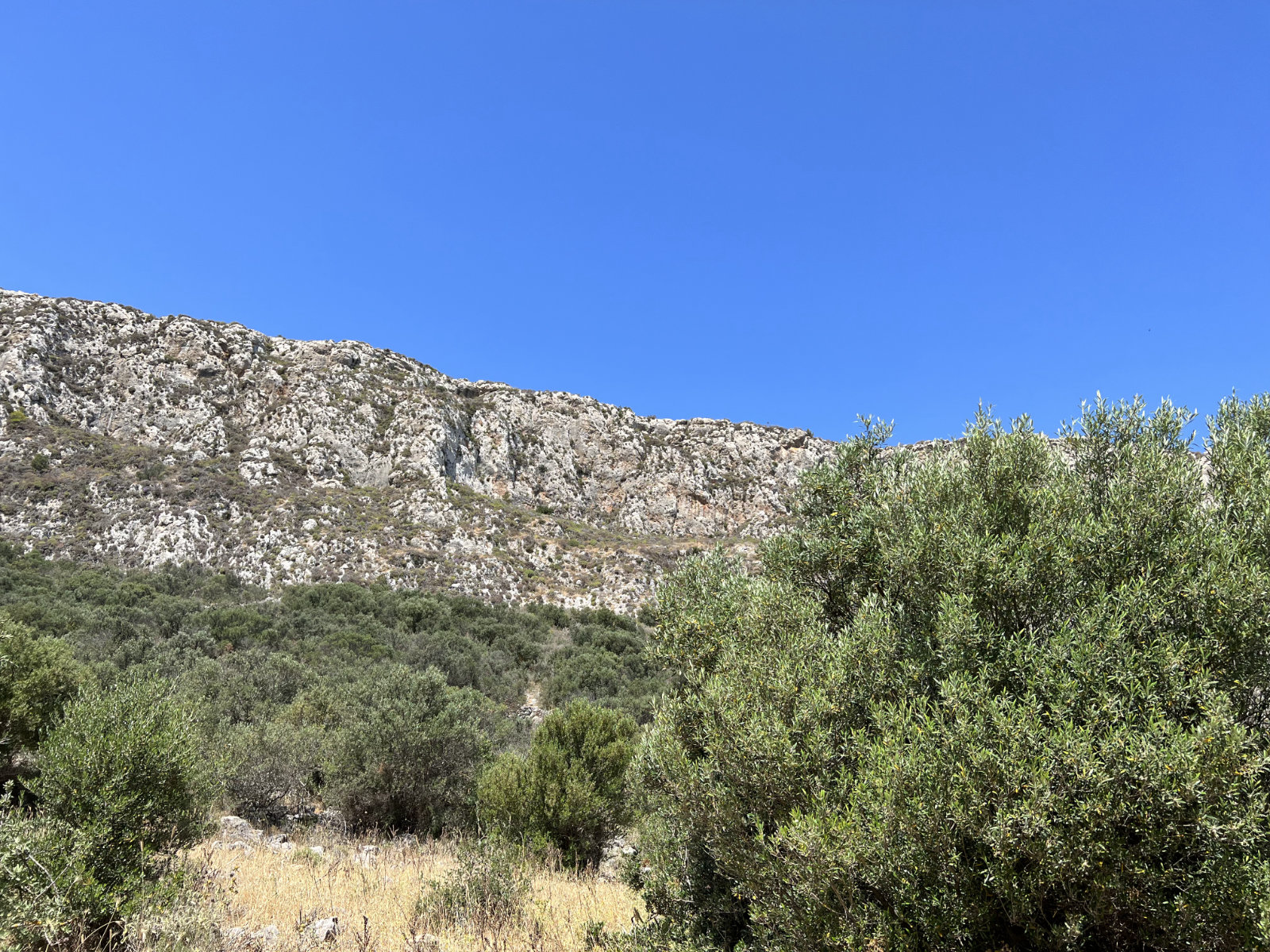
I cleared the way as best I could, but we never found a route to take us up to the ridge, only wildlife paths continually trending south to a (currently empty) watering hole. We gave up and left the path to the thorns and ‘great yellow spiders’. I walked through a lot of spider webs! The spiders never fought back, but when we turned around, and Anghelika led the way, she found herself walking through webs already under repair. Diligent little creatures.
We also encountered a bunch of these sticky thorns, and they were considerably more aggressive in defending against foreign invaders. The irridescent scarabs munching on their flowers were as unperturbed as the spiders.
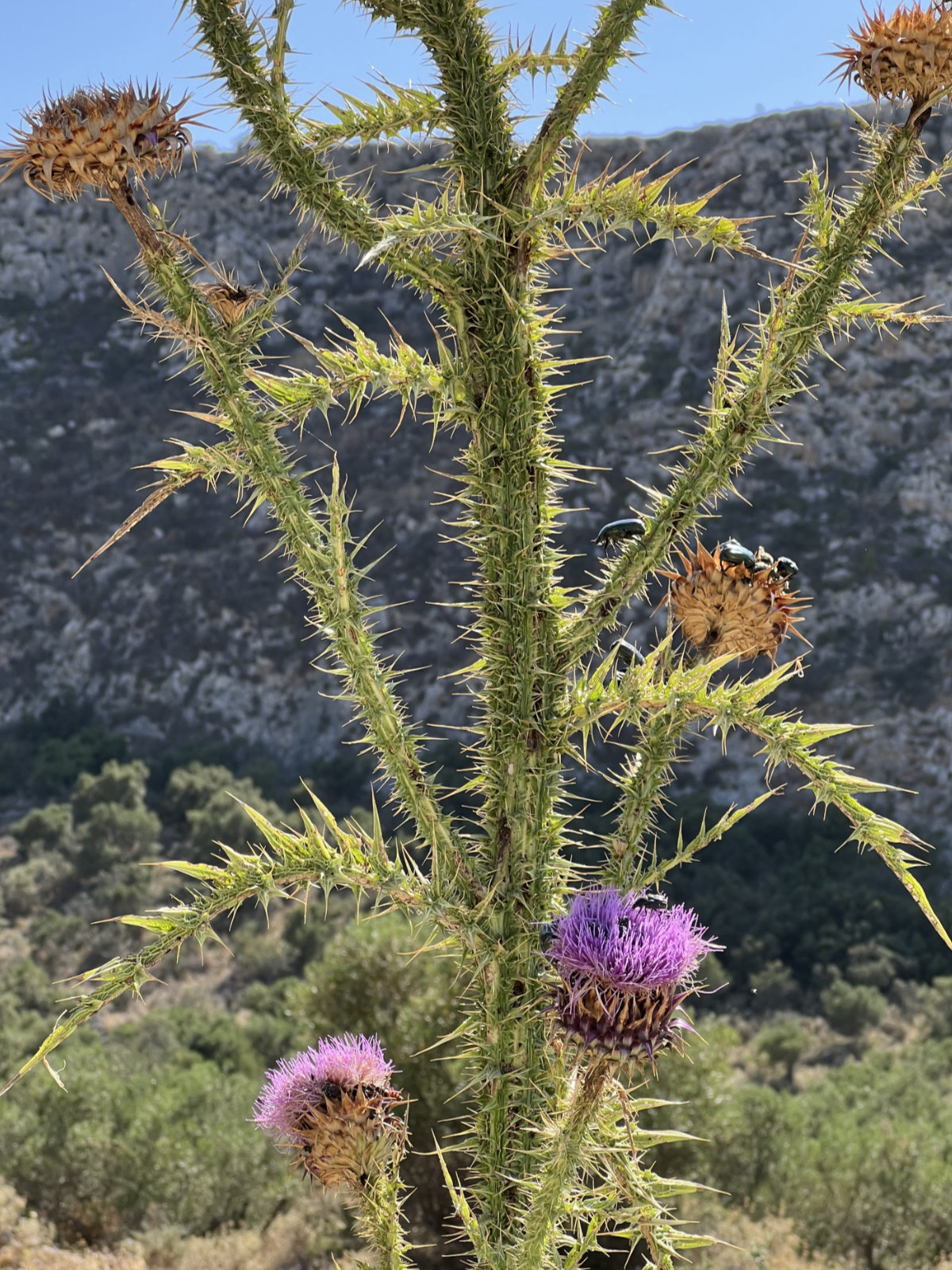
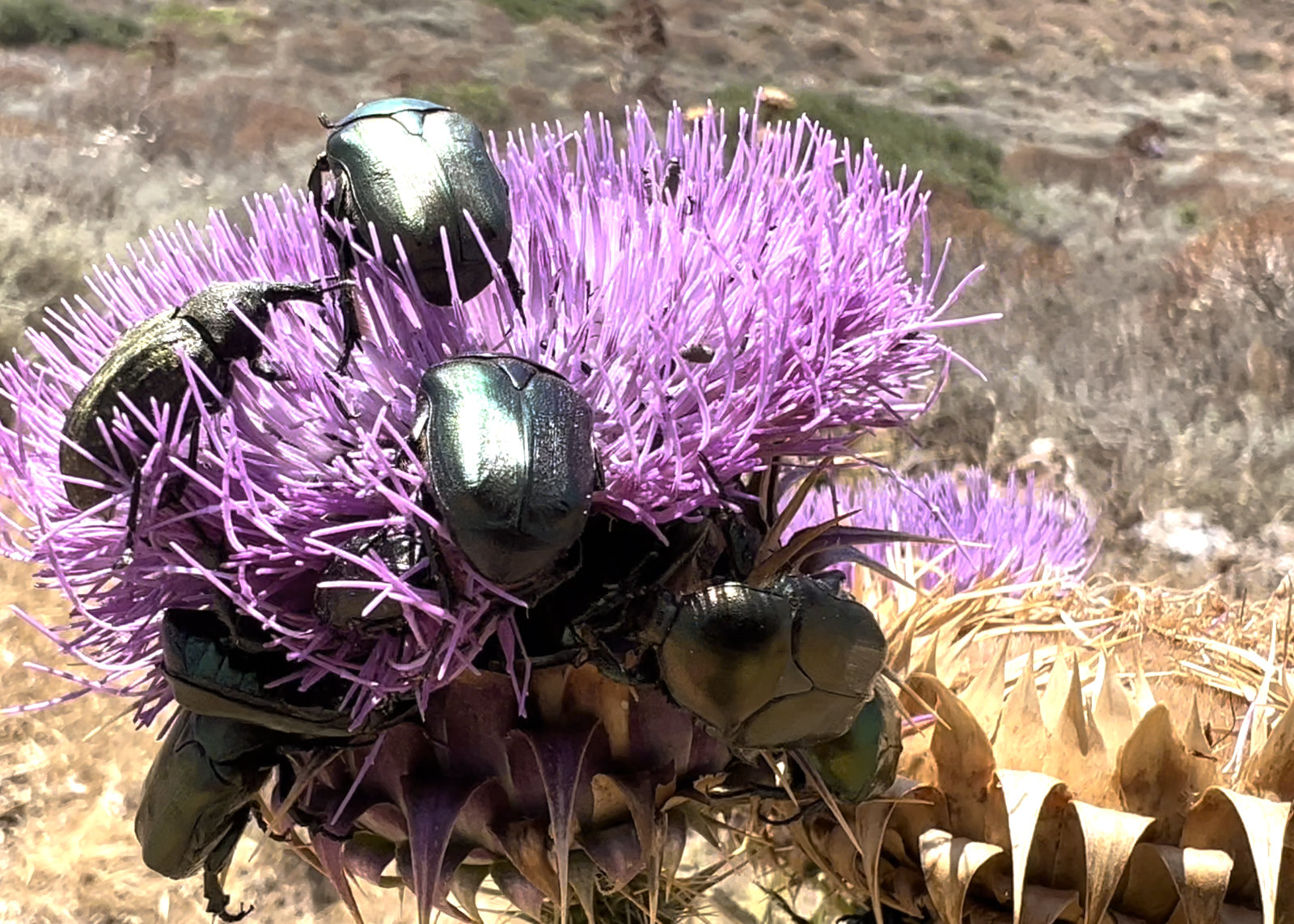
I was disappointed that I couldn’t find the trail, or even get to the base of the cliff. Anghelika encouraged me not to give up: we drove around looking for any sign of a way up, until we met Stavros, the local who confirmed the non-existence of the northern path. But, he said, ‘there is another way …’, assuring us that he climbed the hill for a view of the sea every day. He also said, ‘sometimes I take people like you up, and sometimes I have to go up there to help people get down.’
We took note of his directions and thanked him, unsure of whether we’d have time or energy for another attempt, or whether we could come back in the morning to follow him up the ridge. After a drive to a fish taverna in Liméni, 30 minutes to the north, where we refuelled and refilled our bottles, we returned to make our own attempt. The surviving trail, said Stavros, ‘leaves from the top of the cemetery past Lagoudiá, and is very clear, easy to the top; then it all opens up … anyone with a strong heart and good shoes can walk along the ridge’, where, he said, we would pass several churches. Here is the ‘easy path’ …
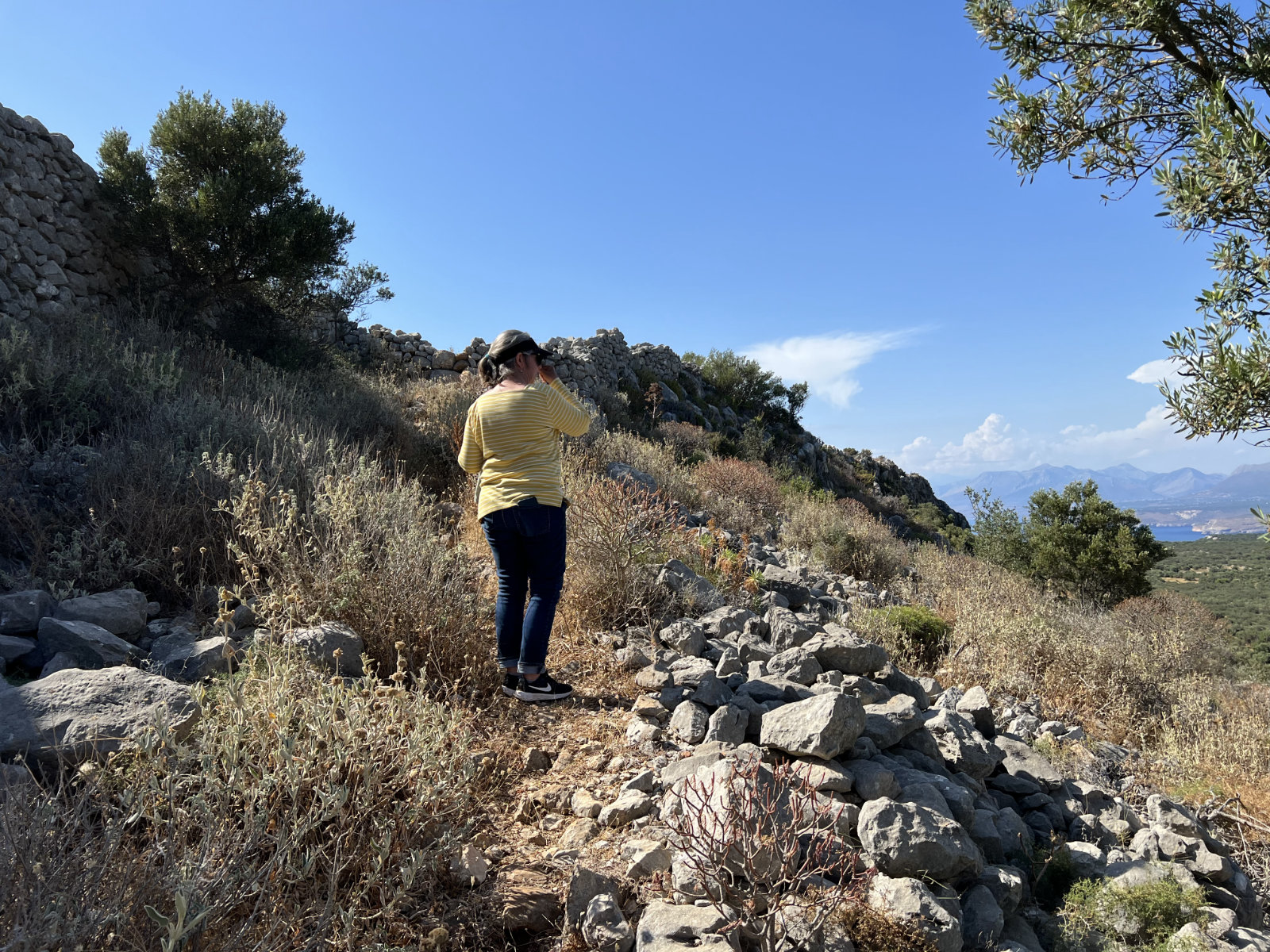
These bushes are indeed ‘the kind that goats don’t eat’, and were prickly-painful to walk through, even for Anghelika, who wore jeans; a short time after we made the ridge, we found the first of Stavros’ churches, complete with ancient columns among the wreckage …


The presence of this column is not itself a sign of great age, but normal practice for the church-builders of Mani, who were happy to repurpose classical ruins in the making of places of worship. Nevertheless, this church could easily be 900 years old. It is not a tourist destination, because, Mani is literally scattered with ruins, ancient and medieval.
Alas, shortly after arriving at this church, the wild rocky way became too rough; it took us 45 minutes to cover the kilometer from cemetery to church and we had 3 more to go … in the heat of the mid-afternoon … through this …
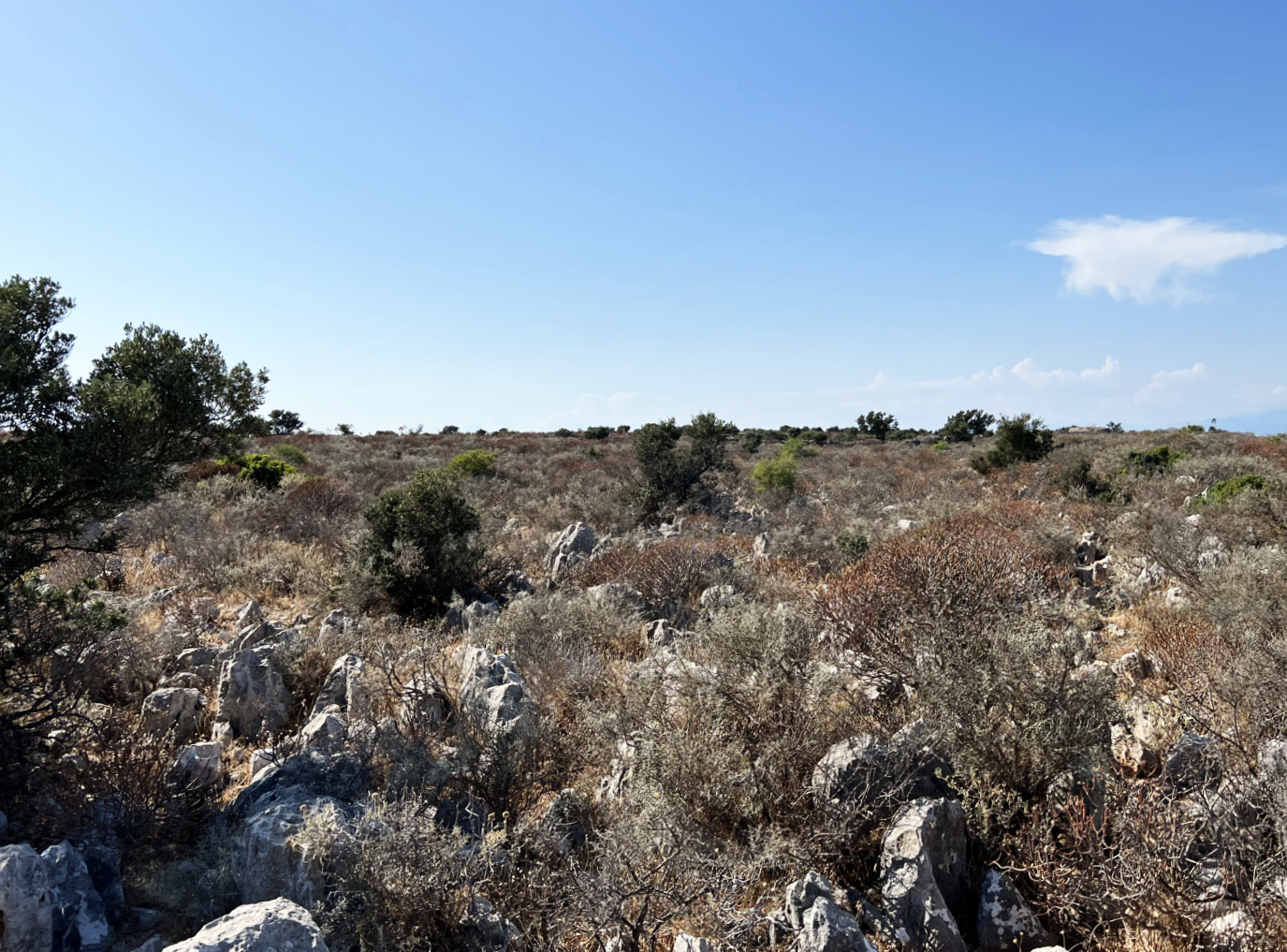
In between the choke of pokey bushes were rocks both sharp and unstable, risking turned ankles and shredded shoes. Both of us were in running shoes, which is a little embarrasing to admit; in my defense, I have hiked thousands of miles through wilderness, under heavy loads, often without trails, most recently in very simple shoes like the ones I was wearing. Nevertheless, I was totally beaten by this landscape. Anghelika and I both wondered whether I needed to reconsider my literary descriptions of Mani’s landscape (‘you need to add more rocks,’ said she), but I remain confident in my depictions. I tell myself that Arpaxos’ father would have led his son on paths known to the locals, like Stavros, during their frequent visits, and that, when the adult Arpaxos came to Agia Sotira, he would have taken his time on what he considered to be his final journey.
Agia Eleousa
I knew that I wouldn’t be able to visit the church that Arpaxos falls to halfway through Isolation, because I wasn’t willing to fall down the cliff face like he did. The real-world church is only accessible from the sea and a rough trail from below, and we didn’t have time to hire a boat. Here is a shot of the entry to the actual church.
Because we couldn’t get to Eleousa, we walked a couple kilometers to another cliffside church built alongside several caves – Agia Odigitria. The many caves in the western cliffs of the deep Mani give the cape its other name, Thyrides, or cape of lockers.
Again, the church I cast in my story is an amalgam of churches I have visited. Odigitria has some of the details common to all old Greek houses of worship, and some that I was pleasantly surprised to see – like the spring running through a cave behind the church that is much like the spring I invented for Arpaxos’ cave.
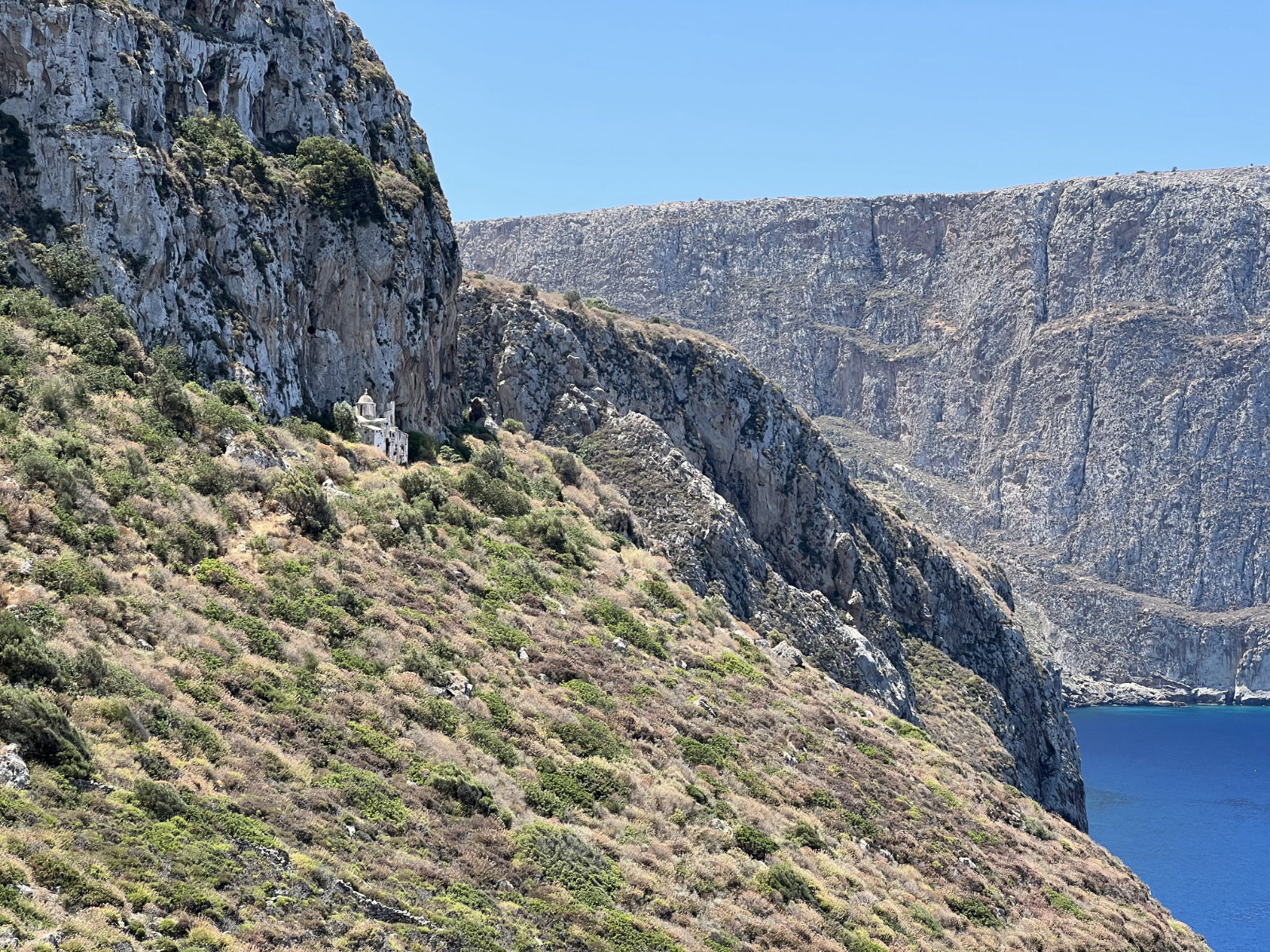
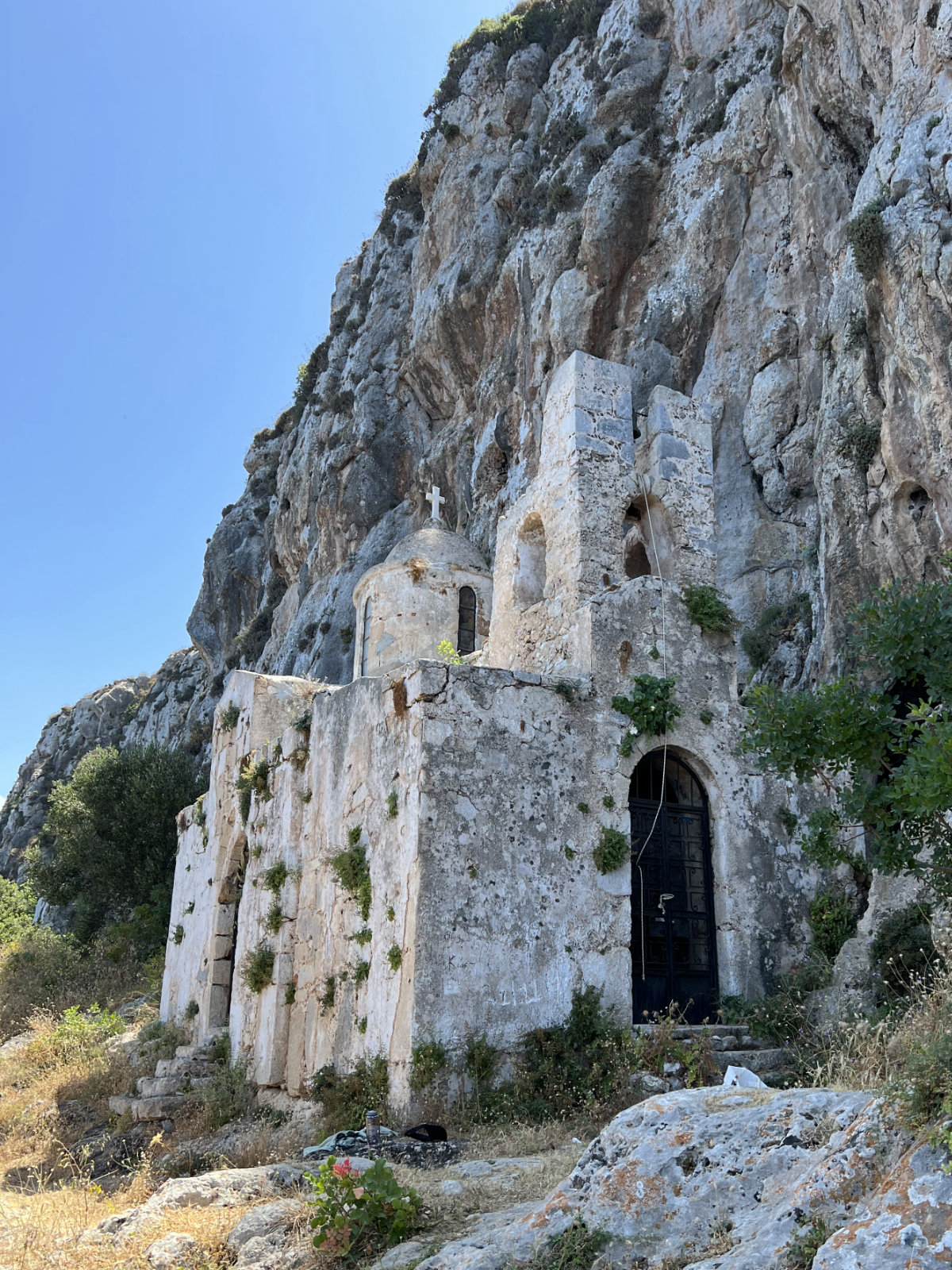

A ‘single, rush-covered chair’ on a marble floor.
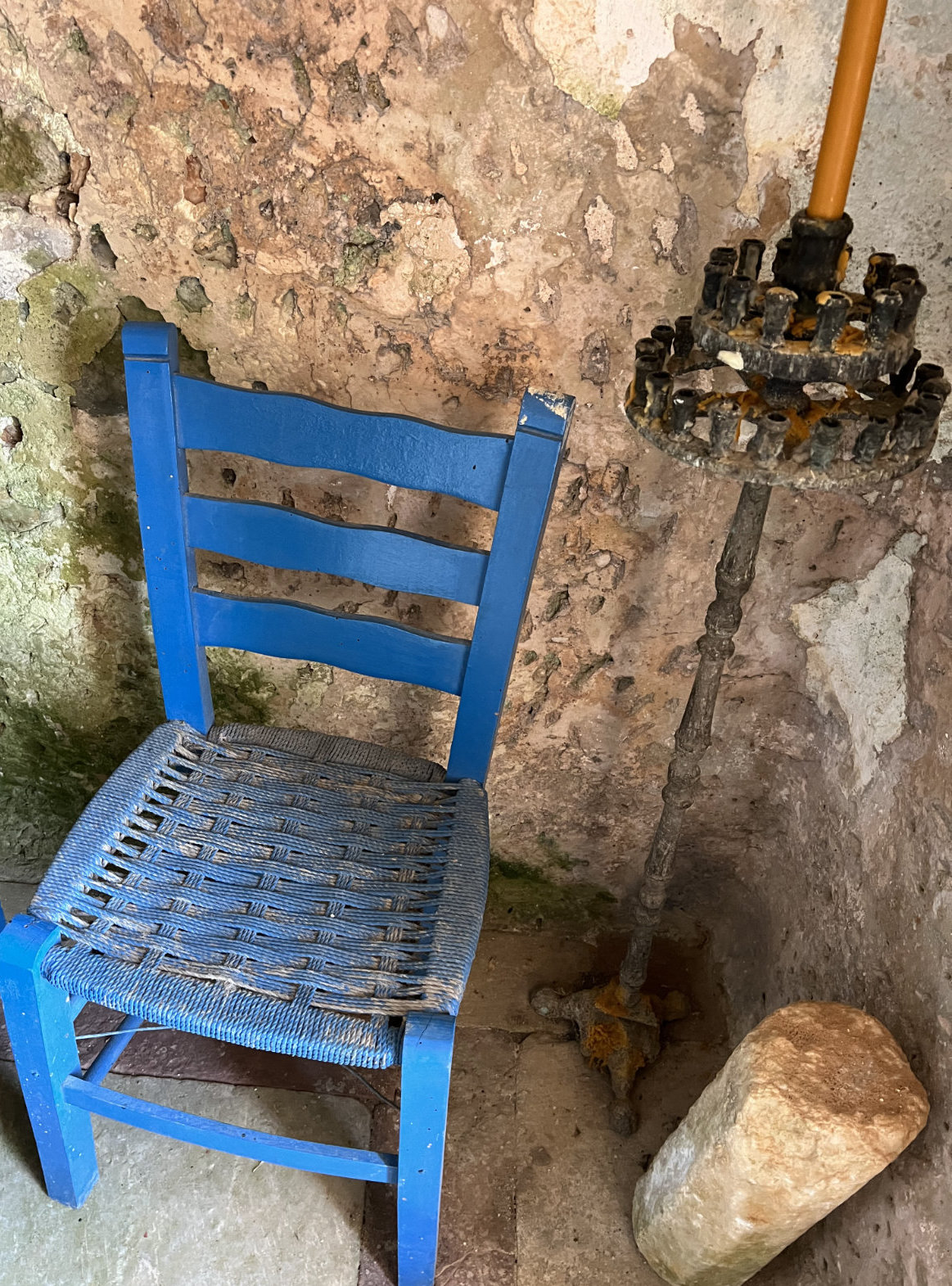
Tamata, or votive offerings, are stamped metal petitions (or signs of gratitude) for healing – the first image has the word for ‘thanks’ stamped in the metal (the Greek word that becomes our English word for eucharist, the meal that celebrates the ultimate grace of God). Underneath are images of body parts, the silver ones ‘tarnished and dull’ …
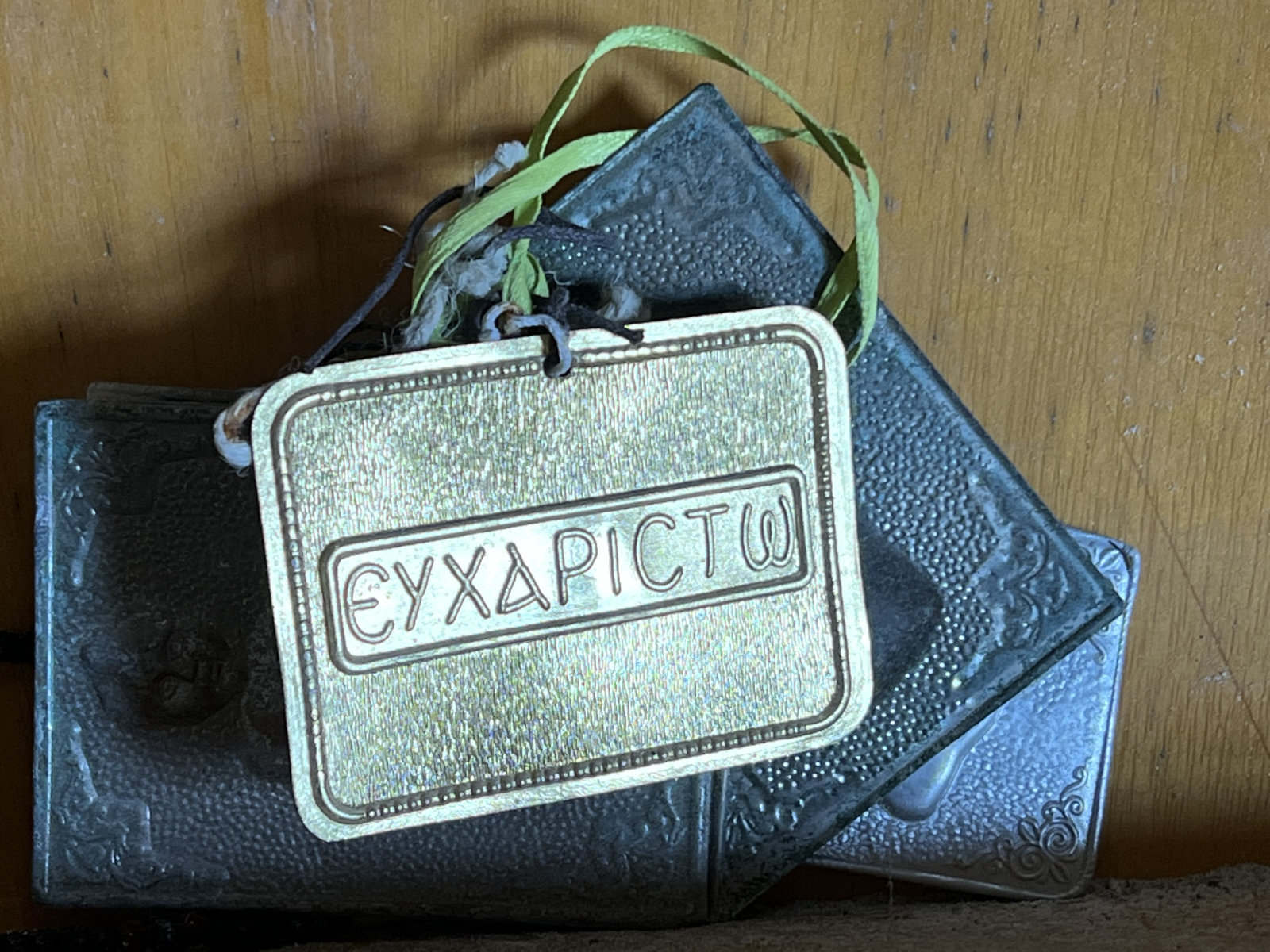
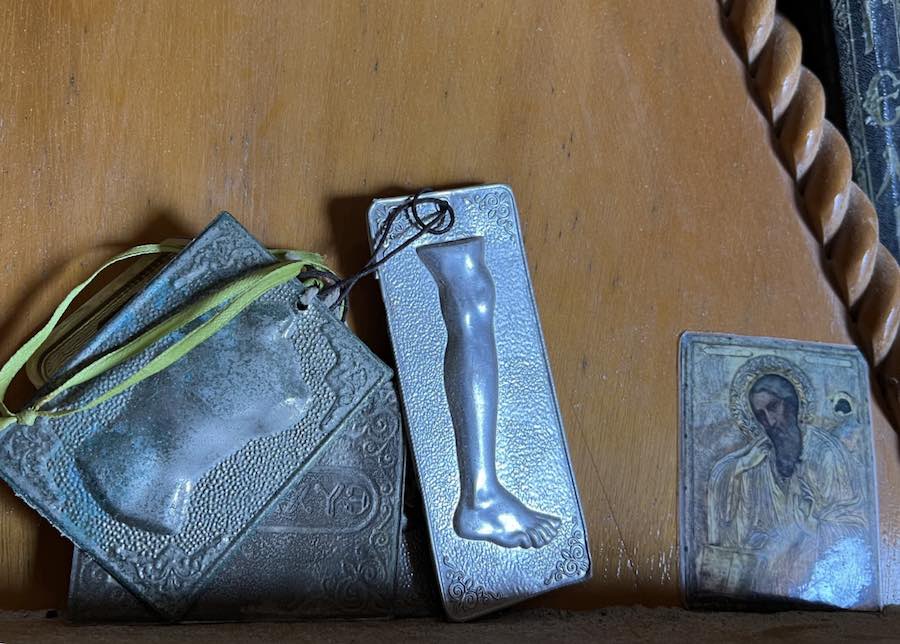
Some tamata surrounding an icon of Agia Elias, or St Elijah.
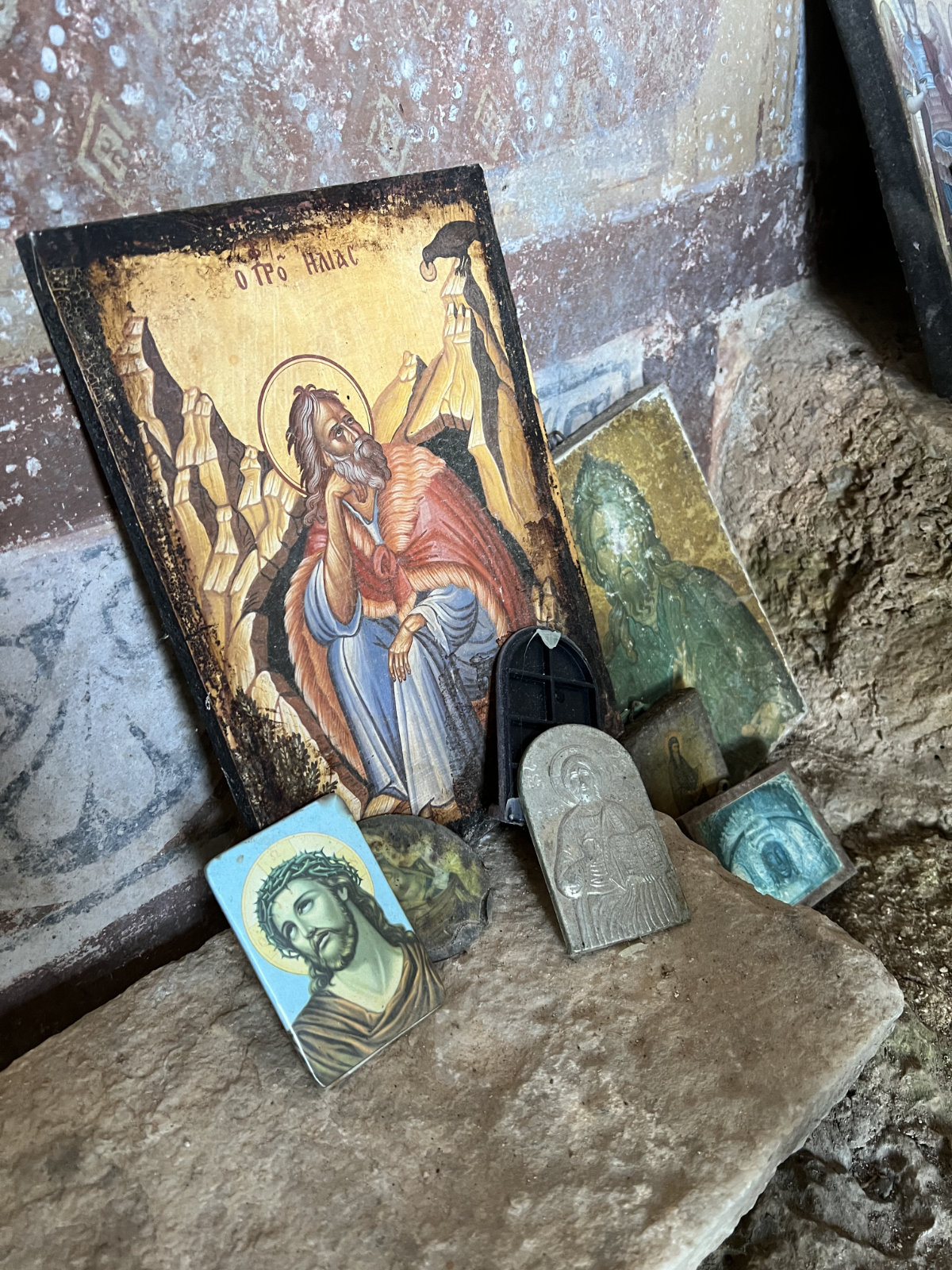
Sometimes the frescoes in churches are damaged by time, sometimes by vandals. In Odigitria, the frescoes are well-preserved. This unique image of an archangel has patterns in his cloak described by little metal nibs.
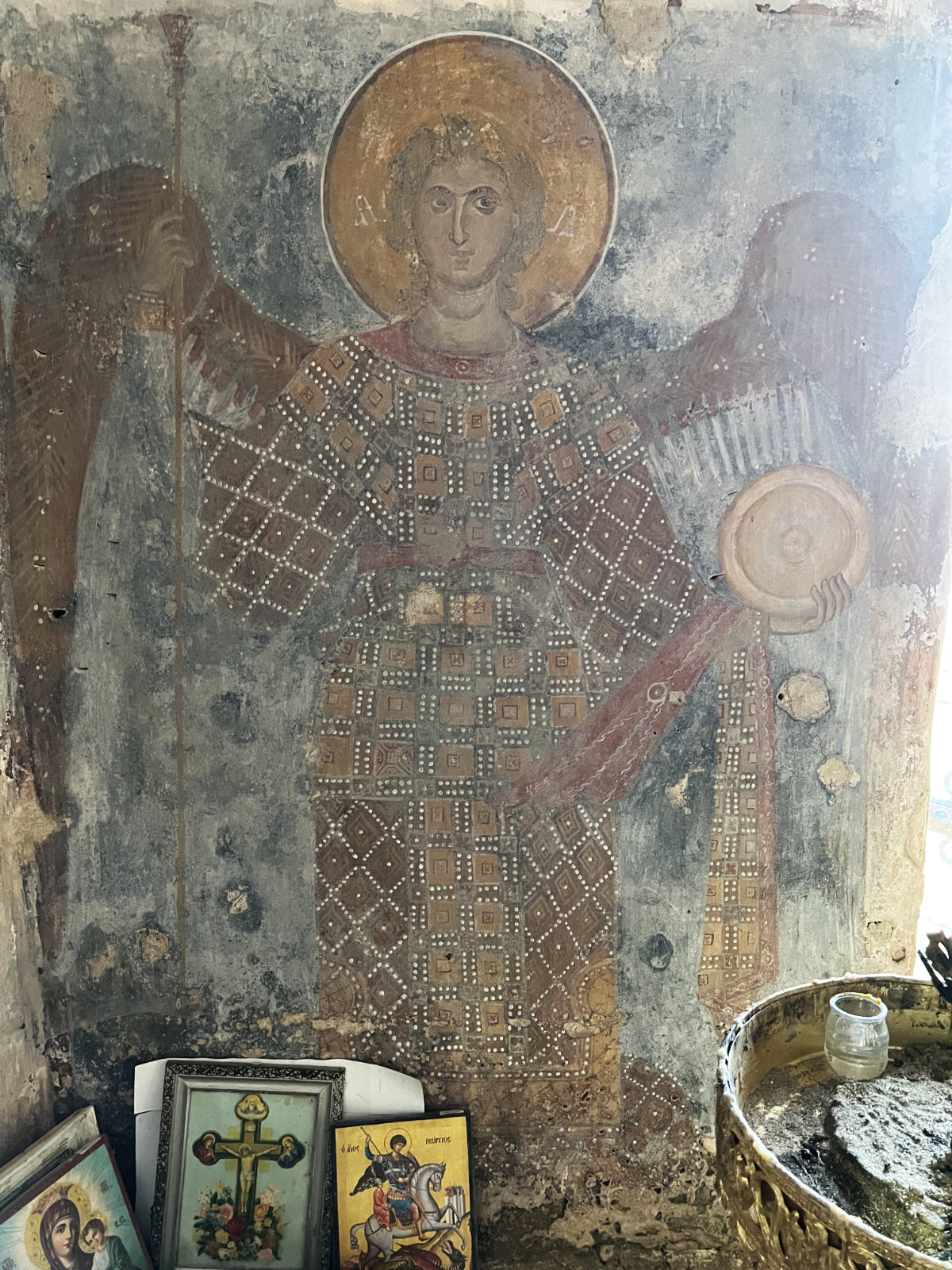
A pretty detail in the floor, showing what I guess is the Cosmos, here depicted with something breaking in from beyond …

A censor for burning incense.
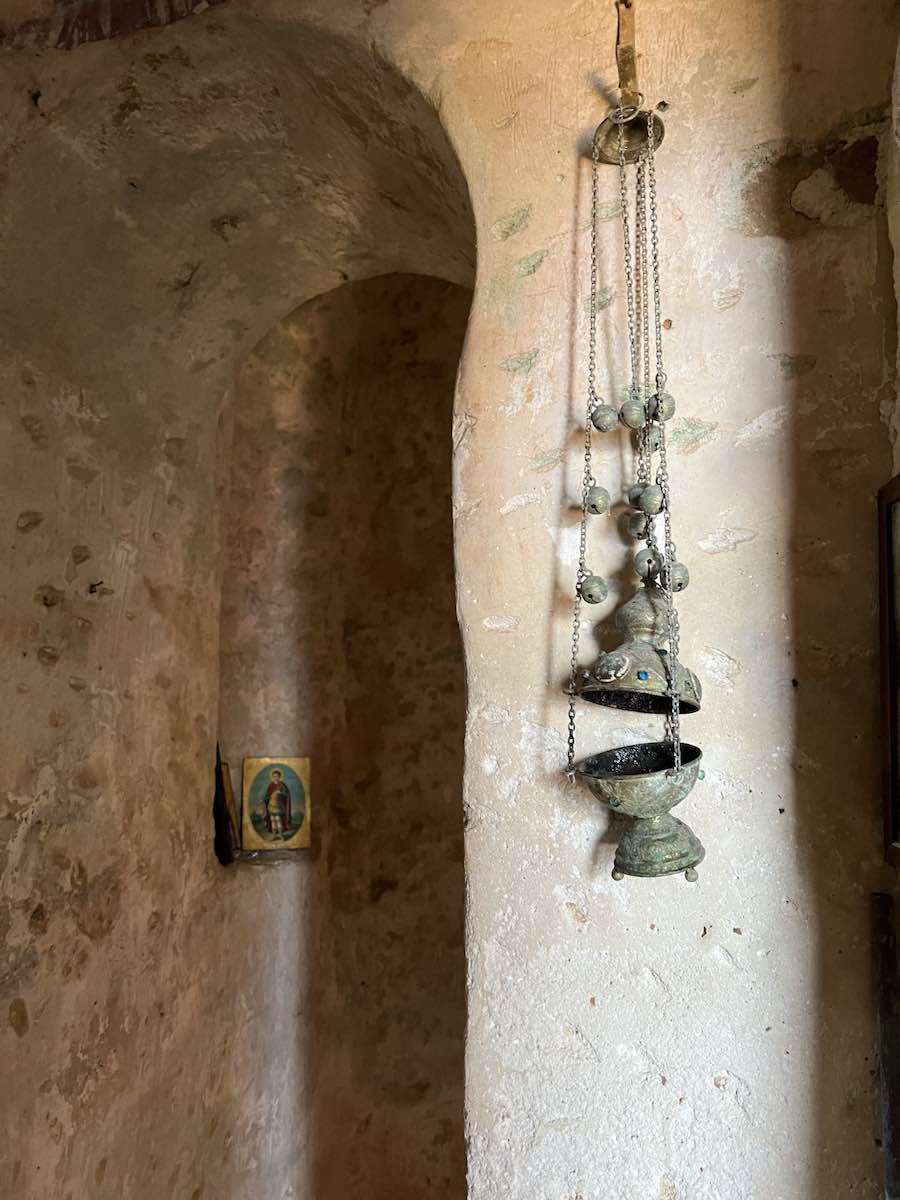
A certain greek woman manifesting that impulse to keep the churches ‘cleaned and swept’.
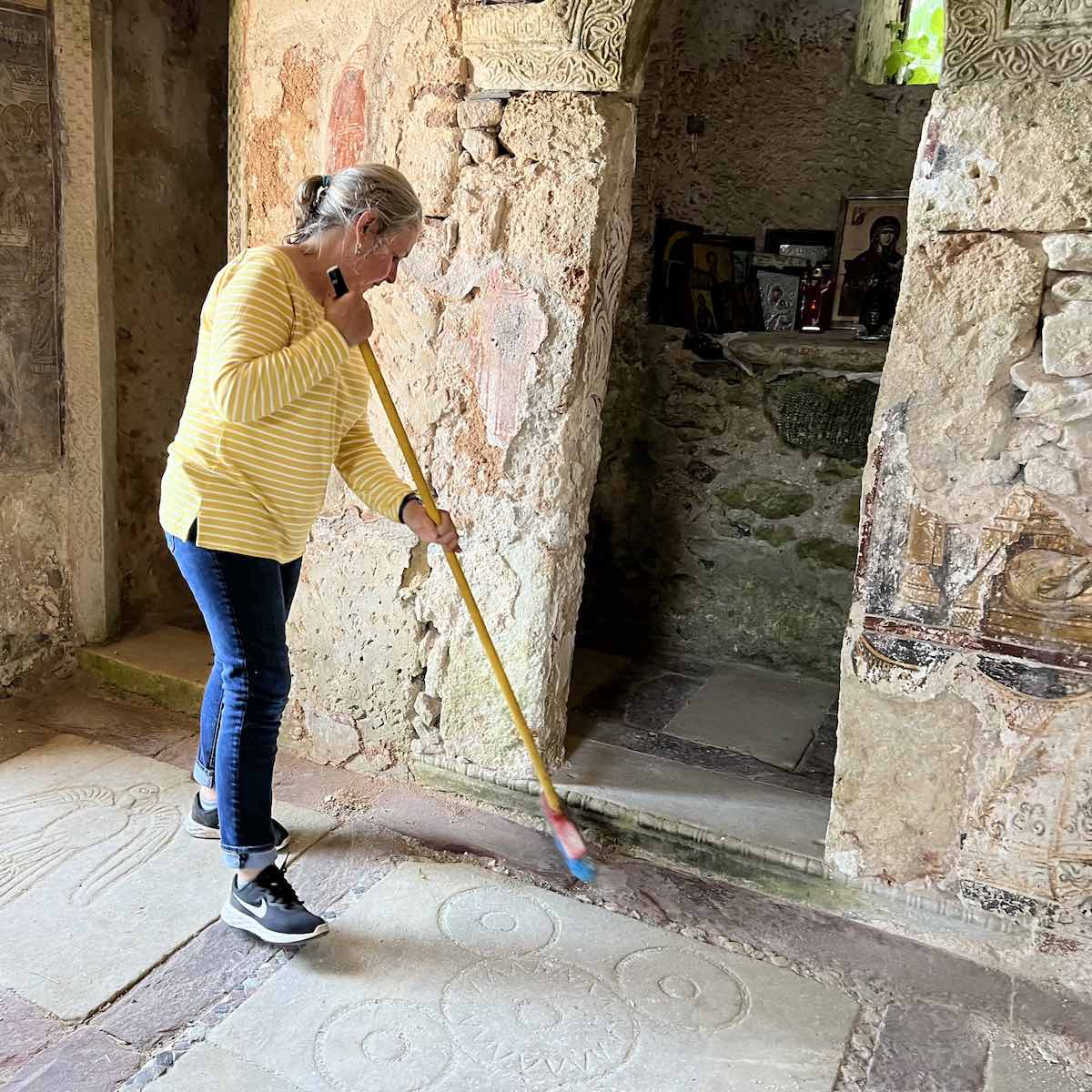
Finally, a couple images of Mani’s towers, from which families would fend off attackers, be they foreign invaders, enemies from other villages, or feuding neighbors within their own.
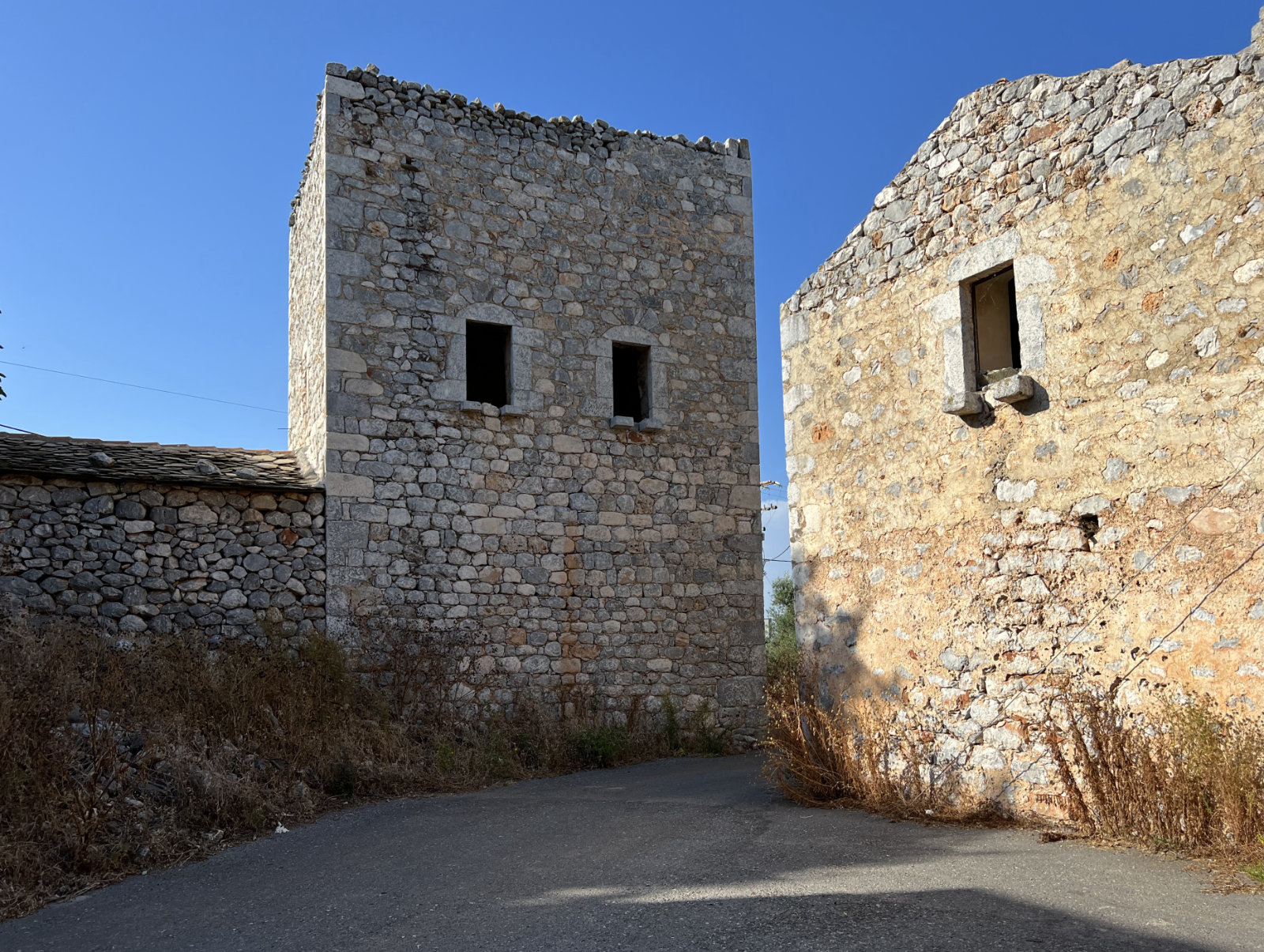

In the end I was pleased that so many small details I wrote about were present in the churches we visited and in the landscape, reinforcing my memories of long-past visits. And I admit to being frustrated that the landscape was also exactly as harsh as I remembered it, so much so that I was prevented from earning membership in the Arpaxos Society. Oh well! Beautiful and wild country. Maybe I will come back at some future date and hire Stavros for the day, try again to get to the church of Agia Sotira. But it isn’t like I need more reasons to return …
